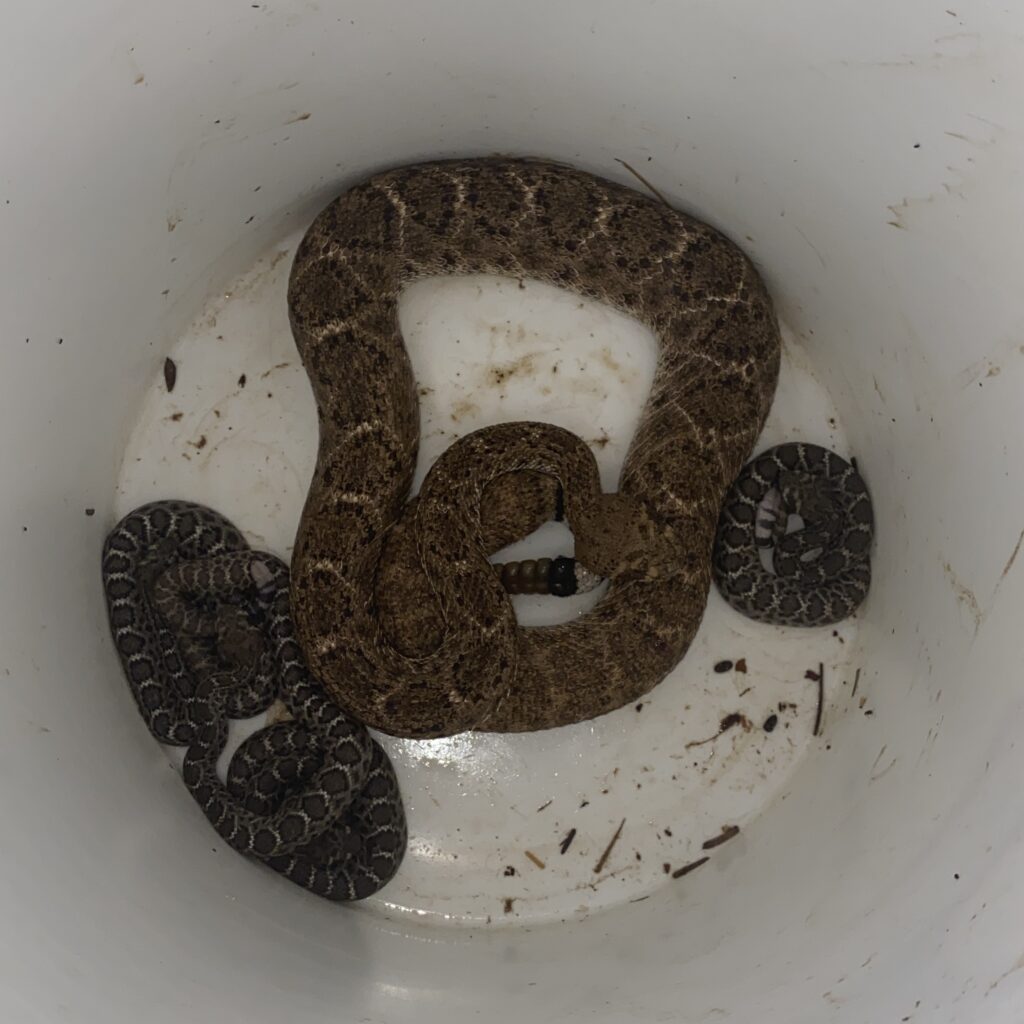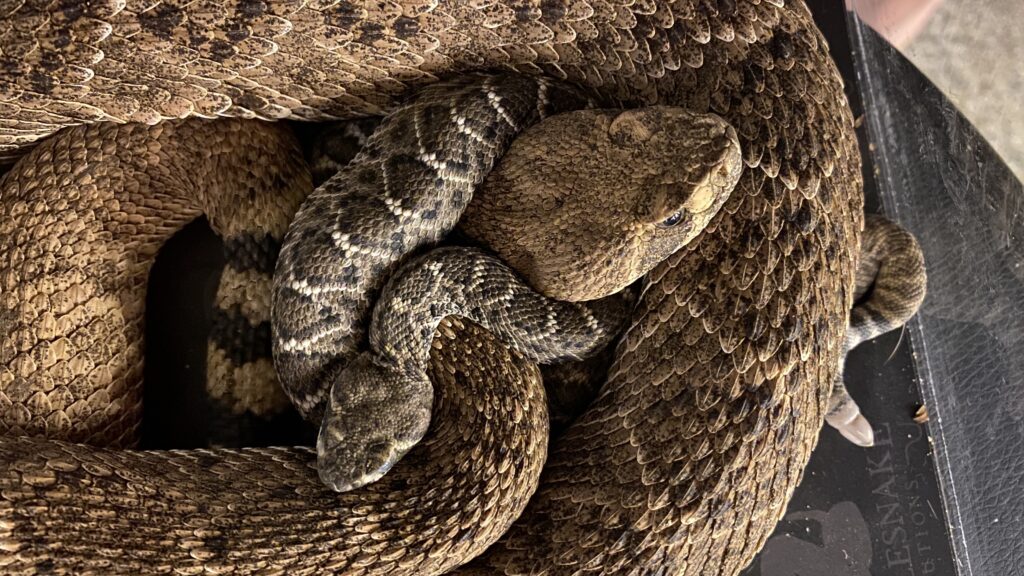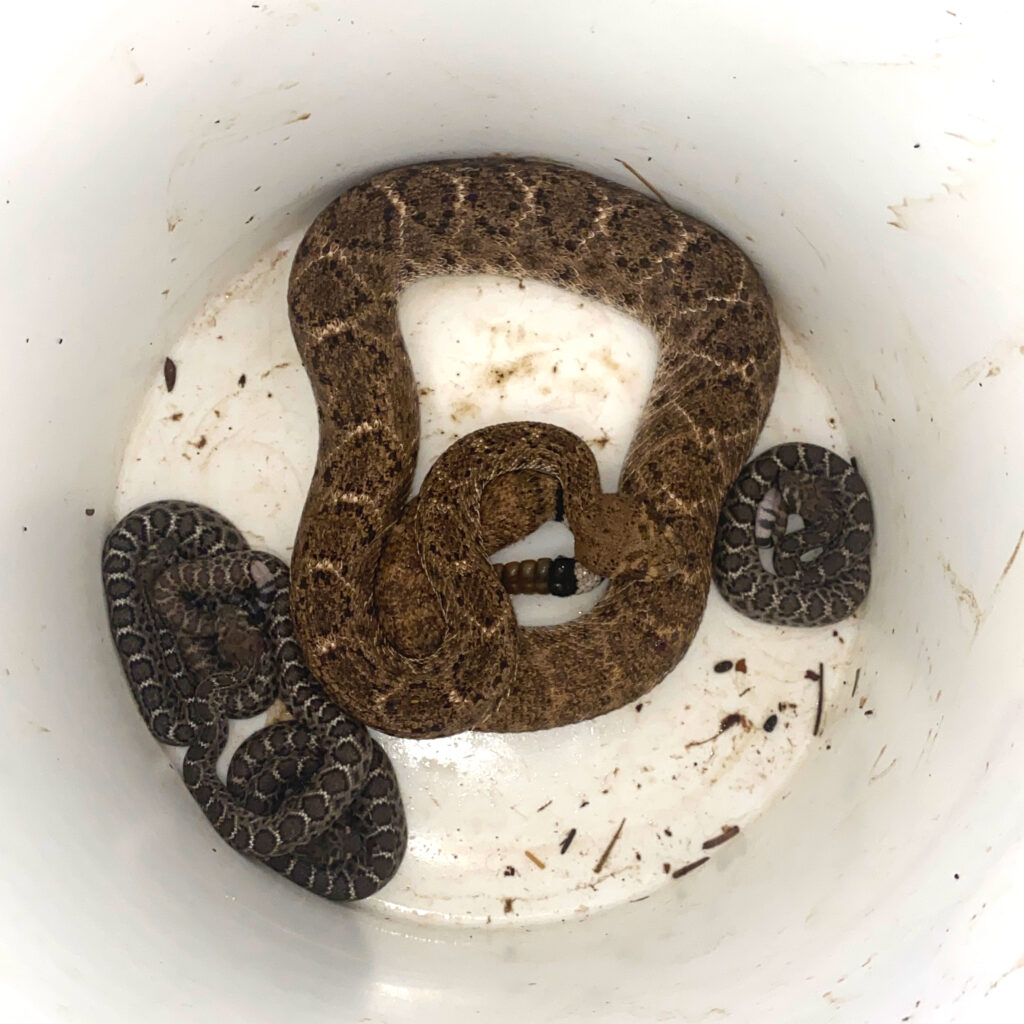Better late than never – rattlesnakes are giving birth, even without the rain. One of the services we offer are serial property inspections, to continuously monitor properties to evaluate possible rattlesnake activity and provide recommendations to landscapers, pest control, and property managers.
We have been inspecting this particular property for many years, and this is the most interesting thing found there to date.
On the previous inspection, Greyson noted a shed skin in an area at the edge of the property. Knowing a fresh shed during this hot and dry period could indicate an estivation den nearby, he focused on that spot during his visit yesterday, and, whoa.

Here is what was found: a late-season estivation den with a mixed bag of Western Diamondback Rattlesnakes, with one having given birth in the recent past, and another in a deep blue phase (preparing to shed skin)
While this is not entirely unusual, what is different about this year is that we are seeing that rattlesnakes are having their babies later than usual, and they are doing so in their estivation dens instead of moving to their usually-preferred birthing spots.
This is likely a response to our exceptionally hot (the hottest on record) summer and near-complete lack of rain. This is similar to a recent visit to a home by Dave in Tucson (I’ll be posting this shortly as well) where he captured a total of 14 rattlesnakes.
Are rattlesnakes giving birth later this year than normal?
According to our observations and activity on the relocation hotline: yes, it appears that rattlesnakes are having babies later this year than usual. In a normal year, we start to receive our first calls to capture groups of mother Western Diamondback Rattlesnakes with their newborn babies in early July, usually hitting its peak around the first week of August, then trickling in here or there until around the first week of September. This year, it took much longer for this to be normal, only now (mid-August) has it become routine.

Likewise, rattlesnakes seen in informal surveys and in our study of rattlesnakes in the Phoenix Mountain Preserve have shown that Western Diamondback Rattlesnake and Tiger Rattlesnakes that would have likely given birth by now are still languishing in a gravid (pregnant) state at estivation dens.
While this is in no way a full representation of what’s happening out there, but does represent 10 years of data collection and informal survey observations. It should also be noted that while this is the case in the Phoenix and Tucson areas, it is unlikely to represent behavior in other regions.
Why are baby rattlesnakes being born later this year than usual?
The most notable difference of this year from previous years is the combination of extreme, prolonged heat and a nearly-complete lack of meaningful rain. It has been documented that the birth time of Western Diamondback Rattlesnakes coincide with the onset of the monsoon rain (G. Schuett et all 2013).
This year makes that a little bit tougher than normal. If monsoon rain triggers pregnant rattlesnakes to give birth, what happens when there is no rain at all?
They have to give birth eventually … so what we are seeing is this: The mother rattlesnakes are staying at estivation sites (spots selected to hide away during the hottest summer months) far longer than they normally would. Rather than moving to a birthing site as they normally would, they are having their babies right in place.
This likely isn’t good for the babies, ultimately and unfortunately. They lose moisture more than twice as quickly as adults (J. Agugliaro, H. Reinert 2005). Unless we get some rain soon, that could be big trouble for this year’s babies. We’re hoping for the best, but looking at the forecast … hoping is all there is to do.
How homeowners can keep baby rattlesnakes out of the yard
Keeping the smallest rattlesnakes out of your area is a bit different than the larger ones.
First, the space they need to get in is much smaller … anything more than about a third of an inch can allow access. Second, they make frequent movements and may not necessarily know where they’re going. Unlike adults, who’ve had a lifetime to map out a homerange, babies may show up any place, any time. For that reason, physical barriers are the best bet. Rather than go too far into detail here, I’ll refer you to our guide to keep baby rattlesnakes out of the yard.
References
Schuett, G.W., Repp, R.A., Hoss, S.K. and Herrmann, H.‐W. (2013), Parturition in a Desert Rattlesnake. Biol J Linn Soc Lond, 110: 866-877. doi:10.1111/bij.12166
Agugliaro J, Reinert HK. Comparative skin permeability of neonatal and adult timber rattlesnakes (Crotalus horridus). Comp Biochem Physiol A Mol Integr Physiol. 2005;141(1):70-75. doi:10.1016/j.cbpb.2005.04.002

